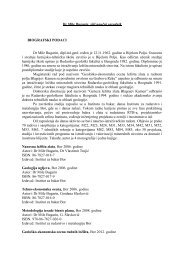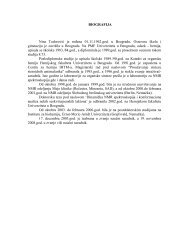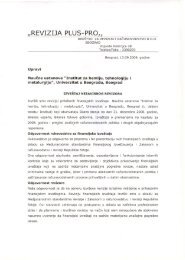Радно искуство - IHTM - Универзитет у Београду
Радно искуство - IHTM - Универзитет у Београду
Радно искуство - IHTM - Универзитет у Београду
You also want an ePaper? Increase the reach of your titles
YUMPU automatically turns print PDFs into web optimized ePapers that Google loves.
Modeling of motor fuel consumption in Serbia with projection to 2025<br />
Dalibor Marinković 1 , Zoran Popović 1 , Aleksandar Orlović 2 , Mirjana Ristić 2<br />
1 University of Belgrade, Institute for Chemistry, Technology and Metallurgy, Belgrade, Serbia<br />
2 University of Belgrade, Faculty of Technology and Metallurgy, Belgrade, Serbia<br />
Abstract<br />
This study is based on the application of mathematical methods of statistical analysis that<br />
can be used to predict the development of motor fuel consumption in the Republic of Serbia.<br />
It is based on the linear dependence of consumption growth of motor fuel from the<br />
development of gross domestic product per capita, which is then corrected by introducing<br />
five additional influencing parameters. The model results indicate that the total consumption<br />
of motor fuels in Serbia from 2010 to 2025 will be increased by 26.5%. Individual<br />
consumption of motor fuels shows different market tendencies. Diesel fuel consumption<br />
expects to continue intensive growth to 2025, even though slightly slower than the<br />
achievements in the last decade. The current trend of declining demand for gasoline will<br />
be stopped from 2015–2016, then followed by slow growth of demand by 2025. Consumption<br />
of liquefied petroleum gasses (LPG) will enter the phase of saturation in 2015.<br />
Keywords: consumption of petroleum products; GDP; mathematical model; Republic of<br />
Serbia.<br />
Available online at the Journal website: http://www.ache.org.rs/HI/<br />
The prediction of energy consumption, and therefore<br />
motor fuel consumption, is an indispensable link in<br />
the process of creating long-term policies and strategies<br />
of maintaining the economic stability and development<br />
of any country. In this context, the modelling of<br />
motor fuel demand has been the subject of many studies<br />
[1–5]. Authors have mainly attempted to evaluate<br />
demand elasticities in relation to price and income [6–<br />
–7]. Thus, the relationship between gross domestic<br />
product (GDP) and energy or oil product demand is well<br />
known [2,4,8].<br />
Current global energy consumption trends and concerns<br />
about global warming put mutually contradictory<br />
requirements. How does the expected intensive economic<br />
growth in middle income countries (Word Bank<br />
economies classification according to 2010 gross national<br />
income per capita, calculated using the World<br />
Bank Atlas method) [9] reconcile with the requirements<br />
for the rationalization of global energy consumptions?<br />
Economic growth inevitably leads to greater use of<br />
energy, and today the most common source of energy<br />
are fossil fuels. However, there are valid reasons to<br />
suggest that this contradiction could be resolved. First,<br />
in almost every case of increase in GDP, when a country<br />
evolves from a middle income to a high income<br />
country, fossil fuel consumption enters a stage of saturation<br />
[2]. Most of the countries where energy use<br />
growth is faster than the GDP are either low or middle<br />
Correspondence: D. Marinković, Institute for Chemistry, Technology<br />
and Metallurgy, Njegoševa 12, 11000 Belgrade, Serbia.<br />
E-mail: dalibor@ihtm.bg.ac.rs<br />
Paper received: 24 February, 2011<br />
Paper accepted: 7 December, 2011<br />
SCIENTIFIC PAPER<br />
UDC 665.6/.7(497.11)“19“<br />
Hem. Ind. 66 (3) 413–423 (2012)<br />
doi: 10.2298/HEMIND110224105M<br />
income countries, while in high income countries, the<br />
GDP is grows faster than energy consumption [4].<br />
Furthermore, the increasing price of fossil fuels encourages<br />
saving, and therefore the use of alternative<br />
fuels. Also, technological progress lead to production of<br />
more economical engines that will also help in rationalizing<br />
the consumption of fuel.<br />
The importance of forecasting consumption of motor<br />
fuels can be observed by their current share of<br />
consumption in total energy consumption. Products<br />
obtained from fossil fuels are still the dominant global<br />
energy source –from the total world consumption of<br />
energy petroleum products account for 34.3% (of<br />
which about 84% is consumed in the form of motor<br />
fuels in the transport sector) [10]. In the past several<br />
years in Serbia, these products have participated in the<br />
final consumption of overall energy with about 39%,<br />
excluding their use as a raw material in the petrochemical<br />
industry, etc. The current share of motor fuels<br />
(gasoline fuel, diesel fuel and liquefied petroleum<br />
gasses) in the national energy demand are at around<br />
28%, and the transport sector consumes about 89% of<br />
these products [11].<br />
This study is based on the application of mathematical<br />
methods of statistical analysis that can be used to<br />
predict the development of motor fuel consumption in<br />
the Republic of Serbia. The designed model is based on<br />
the use of two parameters, which are generally easily<br />
available [7]. The first parameter is an economic indicator<br />
defined by GDP per capita. In order to makes this<br />
parameter even more realistic indicator of the level of<br />
standard of living in one country, it was introduced GDP<br />
PPPPC, gross domestic product per capita calculated at<br />
purchasing power parity. GDP PPPPC is expressed in dol-<br />
413







